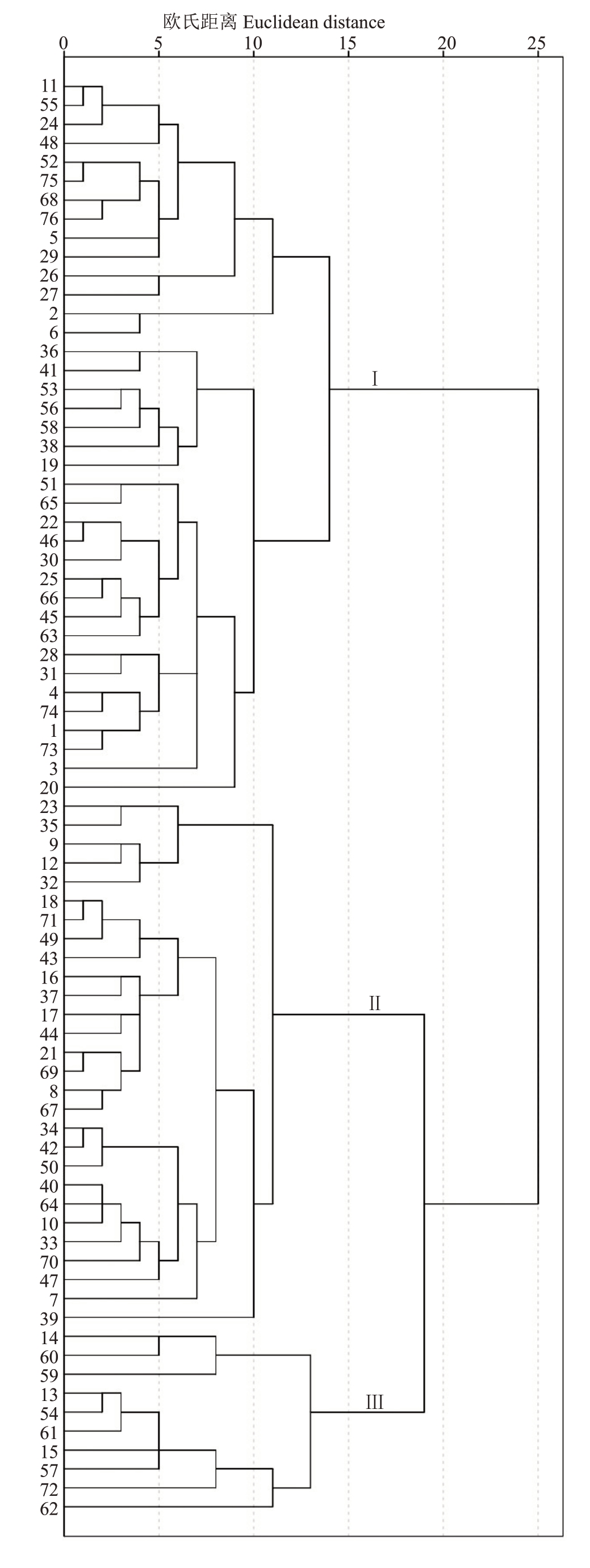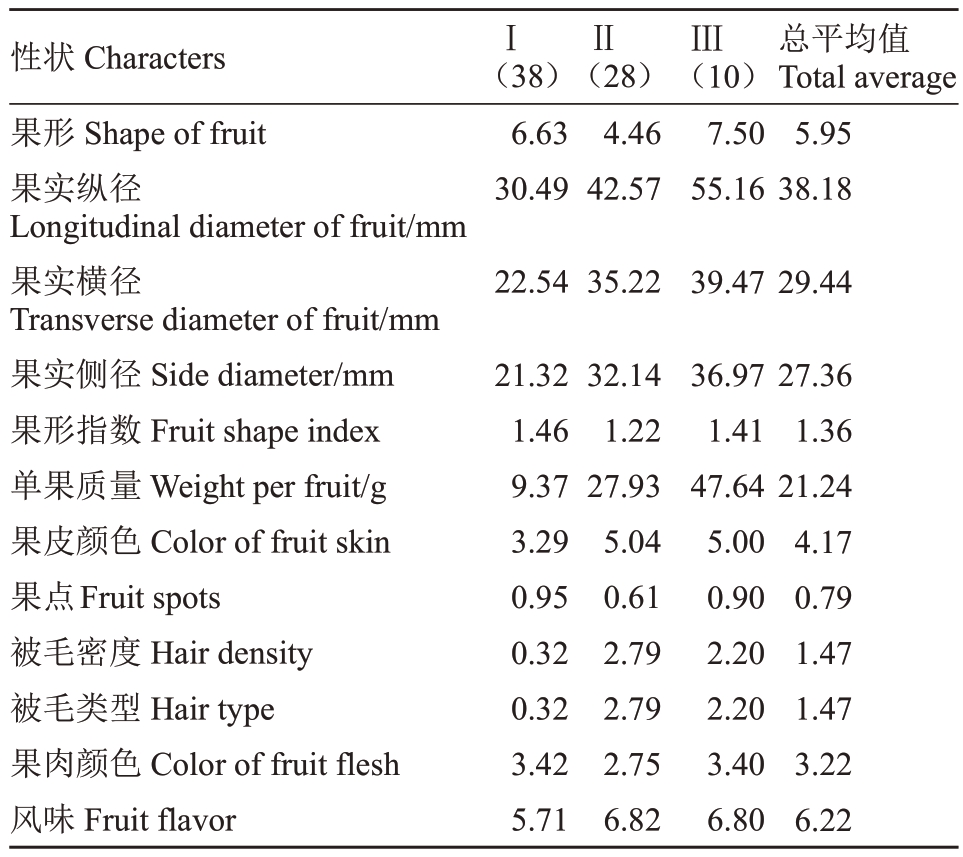猕猴桃(Actinidia chinensis Planch.)为猕猴桃科(Actinidiaceae)猕猴桃属(Actinidia Lindl.)的落叶、半落叶或常绿木质藤本植物[1]。猕猴桃属全世界有66 种、约118 个种下分类单位(变种、变型),目前栽培利用的主要为美味猕猴桃[A.chinensis var.deliciosa(A.Chev.)A.Chev.]和中华猕猴桃(A. chinensis var. chinensis)[2-3]。中国是猕猴桃的起源中心[4],明代李时珍在《本草纲目》中记载:猕猴桃“其形如梨,其色如桃,而猕猴喜食,故有诸名。”[5]。2019 年,中国的猕猴桃种植面积约18.3 万hm2,总产量为219.67万t,种植面积和产量居世界第一位(《2021年猕猴桃产业发展报告》)。
云南省是猕猴桃种质资源分布最为丰富的省份,分布有野生猕猴桃属56 个种、变种及变型[6-7]。目前,云南栽培的猕猴桃品种主要从外地引入,以红阳、Hort16A、东红、金艳等品种为主。就果肉类型来看,品种较为单一,品种结构优化缓慢,影响和制约了云南猕猴桃产业的发展,生产中缺乏具有云南本地特色的品种,地区优势不突出,尚未充分发挥云南省丰富的野生猕猴桃资源优势[1]。因此,选育适宜云南栽培的特色新品种是云南猕猴桃可持续发展的重要工作。
种质资源是选育新品种的物质基础,对种质资源的鉴定评价显得尤为重要[8]。猕猴桃果实性状与产量组成、果实质量等密切相关。多元统计分析是研究多个随机变量之间相互依赖关系以及内在统计规律的一门统计科学,它能够在多个对象和多个指标互相关联的情况下分析它们的统计规律,比较适合农业科学研究的特点。由于其能有效简化数据、揭示数据内在结构、挖掘数据内在规律,已被广泛应用于作物品种分类和育种材料的筛选中[9-10]。
自20世纪80年代末起,云南省丰富的野生猕猴桃种质资源受到广泛关注,科技人员相继开展了相关调查收集工作[11-13]。近年来,对云南省猕猴桃种质资源主要表型性状及营养成分含量方面已开展了一些研究[14-17]。基于主成分分析和聚类分析的猕猴桃果实品质分析和综合评价方面已有一些报道[18-24],而对云南省丰富的猕猴桃种质资源开展果实性状的多元统计分析方面的研究鲜见报道。笔者所在课题组对2019—2021年云南省农业科学院园艺作物研究所收集的76 份猕猴桃种质资源的12 个果实性状进行考察,通过变异度分析、因子分析、相关性分析和聚类分析等多元统计分析方法,对资源进行分析和整理,筛选出一些适合作为育种的材料或直接用于开发利用的资源,为加快云南猕猴桃属种质资源的研究利用提供参考。
1 材料和方法
1.1 材料
供试材料为2019—2021 年从滇东北、滇东、滇东南、滇南和滇西北不同地区收集的76份野生猕猴桃种质材料,编号及采集地见表1和表2。
表1 76 份野生猕猴桃资源的编号
Table 1 Number of 76 wild kiwifruit resources

序号Number 123456789 10 11 12 13 14 15 16 17 18 19 20 21 22 23 24 25 26资源编号Resource number MLP001 MLP013 PB006 PB007 PB017 PB019 SK-1 SK-3 SHNM-1 SHNM-2 SHNM-6 XSD-1 XSD-4 XSD-5 XSD-13 MJG-2 LHDZ-7 LHDZ-8 YH-3 YH-6 DHD-1 MP-1 MP-5 MP-6 MP-7 TC-1采集地Collection site麻栗坡Malipo麻栗坡Malipo屏边Pingbian屏边Pingbian屏边Pingbian屏边Pingbian威信Weixin威信Weixin威信Weixin威信Weixin威信Weixin威信Weixin威信Weixin威信Weixin威信Weixin彝良Yiliang彝良Yiliang彝良Yiliang镇雄Zhenxiong镇雄Zhenxiong镇雄Zhenxiong镇雄Zhenxiong镇雄Zhenxiong镇雄Zhenxiong镇雄Zhenxiong云龙Yunlong序号Number 27 28 29 30 31 32 33 34 35 36 37 38 39 40 41 42 43 44 45 46 47 48 49 50 51 52资源编号Resource number TC-10 CJ-2 CJ-12 CJ-13 CJ-16 LK-4 LK-5 WDXZ-1 WDXZ-3 WD-1 KS-1 KS-2 KS-3 KS-5 KS-6 MG-4 MG-8 MG-11 MG-14 DXS-1 DXS-4 DXS-6 MZ-1 MZ-3 ZX-1 ZX-3采集地Collection site云龙Yunlong云龙Yunlong云龙Yunlong云龙Yunlong云龙Yunlong镇雄Zhenxiong镇雄Zhenxiong镇雄Zhenxiong镇雄Zhenxiong镇雄Zhenxiong镇雄Zhenxiong镇雄Zhenxiong镇雄Zhenxiong镇雄Zhenxiong镇雄Zhenxiong威信Weixin威信Weixin威信Weixin威信Weixin威信Weixin威信Weixin威信Weixin镇雄Zhenxiong镇雄Zhenxiong威信Weixin威信Weixin序号Number 53 54 55 56 57 58 59 60 61 62 63 64 65 66 67 68 69 70 71 72 73 74 75 76资源编号Resource number XCB-7 HWC-1 HWC-5 HJP-1 HJP-4 HJP-5 STC-1 STC-4 STC-5 TJHS-1 TJHS-2 TJHS-4 TJHS-5 TJHS-6 JZS-2 JZS-4 JZS-5 JZS-9 JZS-10 JZS-13 TSH-1 TSH-4 XCFD-1 XPS-1采集地Collection site彝良Yiliang绥江Suijiang绥江Suijiang绥江Suijiang绥江Suijiang绥江Suijiang绥江Suijiang绥江Suijiang绥江Suijiang永善Yongshan永善Yongshan永善Yongshan永善Yongshan永善Yongshan师宗Shizong师宗Shizong师宗Shizong师宗Shizong师宗Shizong师宗Shizong西畴Xichou西畴Xichou西畴Xichou西畴Xichou
表2 野生猕猴桃资源采集地生态环境
Table 2 Ecological environment of wild kiwifruit resources collection sites

采集地Collection site麻栗坡Malipo屏边Pingbian威信Weixin镇雄Zhenxiong彝良Yiliang绥江Suijiang永善Yongshan西畴Xichou师宗Shizong云龙Yunlong经度Longitude 104°33'~105°18'103°24'~103°58'104°41'~105°18'104°18'~105°19'103°51'~104°45'103°47'~104°16'103°15'~104°01'104°22'~104°58'103°42'~104°34'98°52'~99°46'纬度Latitude 22°48'~23°34'22°49'~23°23'27°42'~28°07'27°17'~27°50'27°16'~27°57'28°21'~28°40'27°31'~28°32'23°06'~23°37'24°20'~25°00'25°28'~26°23'气候Climate亚热带季风气候Subtropical monsoon climate亚热带湿润山地季风气候Subtropical humid mountain monsoon climate亚热带季风气候Subtropical monsoon climate亚热带季风气候Subtropical monsoon climate中亚热带湿润气候Subtropical humid climate高原季风立体气候Plateau monsoon stereoscopic climate温带季风气候Temperate monsoon climate亚热带季风气候Subtropical monsoon climate亚热带季风气候Subtropical monsoon climate温带季风气候Temperate monsoon climate采集份数Collection number 24 18 19 485466
1.2 果实形态指标测定方法
果实成熟期,参照《猕猴桃种质资源描述规范和数据标准》[25]的要求,观测果形、果点、果皮颜色、被毛等性状指标;用天平测定果实的单果质量,用游标卡尺测定果实纵径、果实横径、果实侧径,计算果形指数[17],果形指数=果实纵径/果实横径。
对材料的果形、果皮颜色、果肉颜色、被毛状况等果实相关质量性状进行数量化赋值,具体标准如下[26]:
(1)果形:短圆=1,梯形=2,短圆柱=3,长圆柱=4,圆球形=5,扁圆形=6,卵形=7,圆柱形=8,倒卵形=9,椭圆形=10,短椭圆形=11,长椭圆形=12。
(2)果皮颜色:浅绿=1,绿=2,深绿=3,浅褐=4,褐色=5,深褐=6,浅红=7,红=8,紫红=9。
(3)果点:不明显=0,明显=1。
(4)被毛密度:无=0,稀=1,中=2,密=3,极密=4。
(5)被毛类型:无=0,短茸毛=1,长茸毛=2,硬毛=3,刚毛=4,糙毛=5,毡毛=6。
(6)果肉颜色:浅绿=1,绿=2,翠绿=3,深绿=4,黄绿=5,浅黄=6,黄=7,金黄=8,橙色=9,浅红=10,紫红=11,浅绿+紫红=12。
(7)风味:涩=1,苦=2,酸=3,微酸=4,甜酸=5,酸甜=6,甜=7。
1.3 数据统计分析
利用软件Excel 2003对果实相关性状数据的变异度进行计算分析,利用SPSS 17.0软件进行性状的相关性分析、因子分析和聚类分析等多元统计分析[27]。
2 结果与分析
2.1 变异度分析
变异度分析结果表明(表3),12 个果实性状的平均变异系数为55.88%,其中被毛密度和被毛类型的变异系数居前二位,达113.49%和117.01%,变幅分别为0.00~4.00和0.00~6.00;果肉颜色、单果质量、果形和果点的变异系数较大,分别为78.57%、67.94%、62.52%和51.90%;果实纵径、果实横径、果实侧径、果形指数、果皮颜色和风味的变异系数都在50%以下,变异系数最小的性状为风味,仅为23.96%。表明,采自不同生态区域的76份野生猕猴桃果实性状的表现存在显著的遗传差异,考察的12个果实性状在不同材料间表现出不同程度的多样性。
表3 供试材料果实性状变异情况
Table 3 Variations of fruit characters in the tested materials

性状Character果形Shape of fruit果实纵径Longitudinal diameter of fruit/mm果实横径Transverse diameter of fruit/mm果实侧径Side diameter/mm果形指数Fruit shape index单果质量Single fruit weight/g果皮颜色Colour of fruit skin果点Fruit spots被毛密度Hair density被毛类型Hair type果肉颜色Colour of fruit flesh风味Flavor平均值Mean 5.95 38.18 29.44 27.36 1.36 21.24 4.17 0.79 1.26 1.47 3.22 6.22最大值Maximum 12.00 66.12 44.71 41.01 2.61 58.34 9.00 1.00 4.00 6.00 12.00 7.00最小值Minimum 1.00 20.32 8.91 7.73 0.84 0.76 1.00 0.00 0.00 0.00 1.00 1.00极差Range 11.00 45.80 35.80 33.28 1.77 57.58 8.00 1.00 4.00 6.00 11.00 6.00标准差Std.3.72 10.10 8.49 7.62 0.38 14.43 1.84 0.41 1.43 1.72 2.53 1.49变异系数CV/%62.52 26.45 28.84 27.85 27.94 67.94 44.13 51.90 113.49 117.01 78.57 23.96
2.2 因子分析
对76份供试材料的果实性状进行了因子分析,结果表明,前3 个因子的累积贡献率达73.843%,利用最大方差旋转法得到因子特征值和特征向量的因子载荷值(表4)。由表4可知,因子1的果实横径和果实侧径有较高的载荷值,分别为0.948和0.935,这两个性状反映了野生猕猴桃果实的质量,可视为果实质量因子,表明在猕猴桃育种中,若要提高果实质量,则需要重点考虑果实横径和侧径;因子2中果形指数的载荷值最高,为0.740,该性状与果实形状有关,可视为果形因子;因子3的果点和果形的载荷值较高,分别为0.689和0.551,这2个性状与果实外观有密切关系,可称为外观因子。
表4 因子载荷矩阵
Table 4 Loading matrix of factors

性状Factors果形Shape of fruit果实纵径Longitudinal diameter of fruit果实横径Transverse diameter of fruit果实侧径Side diameter果形指数Fruit shape index单果质量Single fruit weight果皮颜色Color of fruit skin果点Fruit spots被毛密度Hair density被毛类型Hair type果肉颜色Color of fruit flesh风味Fruit flavor特征值Eigenvalues贡献率Contributive rate/%累计贡献率Cumulative contributive rate/%因子1 Factor 1-0.301 0.768因子2 Factor 2 0.492 0.388因子3 Factor 3 0.551 0.369 0.948-0.199 0.080 0.935-0.465 0.899 0.498-0.364 0.804 0.796-0.207 0.586 5.526 46.052 46.052-0.212 0.740 0.061 0.573-0.320 0.294 0.233 0.134-0.458 1.828 15.230 61.282 0.137 0.205 0.251-0.305 0.689-0.115-0.105-0.588 0.008 1.507 12.561 73.843
2.3 相关性分析
相关性分析是将2个或多个具备相关性的变量元素进行分析,从而衡量2 个变量因素的相关密切程度。农作物产量等重要农艺性状则由多基因控制,且基因之间相互关联,适合进行相关性分析[28]。由表5 可知,有25 对性状间呈极显著正相关,有7对性状间呈极显著负相关,有3 对性状间呈显著正相关,5 对性状之间呈显著负相关,其中单果质量与果实侧径、横径和纵径3 个性状呈极显著正相关,其相关程度大小依次为果实侧径(0.910)、果实横径(0.906)和果实纵径(0.867)。果实风味与果实侧径、横径和纵径3 个性状也呈极显著正相关,其相关程度大小依次为果实侧径(0.574)、果实横径(0.563)和果实纵径(0.349),此外,相关系数在0.700 以上呈极显著正相关的性状有果实侧径与果实纵径、果实侧径与横径,以及被毛类型与被毛密度。从相关性来看,果实侧径与横径、单果质量与果实侧径和果实横径的关系更为密切,果实风味与果实质量因子即果实侧径、果实横径和果实纵径密切相关,表明在猕猴桃育种中,以提高单果质量和果实风味为目标时,需要重点考虑果实质量因子。
表5 不同果实性状间的相关系数
Table 5 Correlation coefficient of different fruit characters

注:*表示p<0.05 显著水平;**表示p<0.01 极显著水平。1.果形;2.纵径;3.横径;4.侧径;5.果形指数;6.单果质量;7.果皮颜色;8.果点;9.被毛密度;10.被毛类型;11.果肉颜色;12.风味。
Note:*significant level at p<0.05;**very significant level at p<0.01.1.Shape of Fruit;2.Longitudinal diameter of fruit;3.Transverse diameter of fruit; 4.Side diameter of fruit; 5.Fruit shape index; 6.Weight per fruit; 7.Color of fruit skin; 8.Fruit spots; 9.Hair density; 10.Hair type;11.Color of fruit flesh;12.Fruit flavor.
性状Character 1 2 3 4 5 6 7 8 9 10 11 12 123456789 10 11 12 1.000 0.095-0.293*-0.263*0.424**-0.122-0.071 0.211-0.208-0.161-0.074-0.362**1.000 0.693**0.705**0.092 0.867**0.489**-0.131 0.611**0.536**-0.185 0.349**1.000 0.986**-0.607**0.906**0.310**-0.223 0.639**0.677**-0.165 0.563**1.000-0.595**0.910**0.285*-0.176 0.615**0.639**-0.187 0.574**1.000-0.287*0.097 0.102-0.192-0.265*0.083-0.488**1.000 0.378**-0.152 0.606**0.622**-0.148 0.456**1.000-0.412**0.527**0.465**0.141 0.146 1.000-0.473**-0.424**-0.198-0.074 1.000 0.798**-0.257*0.291*1.000-0.200 0.255*1.000-0.158 1.000
2.4 聚类分析
采用系统聚类(Hierarchical clustering)中的组间联接法(Average linkage between groups),以欧氏距离(Euclidean distance)为遗传距离对76份材料进行聚类分析,结果见图1。由图1 可知,在欧氏距离大约为19 时,可将76 份猕猴桃材料划分为3 大类。结合图1 和表6,第Ⅰ类包括38 份材料,果实纵径、横径和侧径均比第Ⅱ类和第Ⅲ类短,单果质量最小,果实最小,大多数为无毛的斑果类型,大部分材料不适合作为选育鲜食类型品种的材料,但其中的如紫果猕猴桃等少数种类材料可作为选育小果型的鲜食猕猴桃品种材料;第Ⅱ类包括28 份材料,被毛多为长绒毛,果实纵径、横径、侧径和单果质量介于第Ⅰ类和第Ⅲ类之间,单果质量接近30 g;第Ⅲ类包括10份材料,果形为倒卵形和长圆柱形,果实纵径、横径和侧径均比第Ⅰ类和第Ⅱ类长,果实最大,单果质量也最大,且被毛密度平均值比第Ⅱ类小,单果质量约达50 g,形态学鉴定结果也表明,第Ⅲ类材料大部分风味甜,适合用于选育中果型鲜食品种材料。

图1 基于果实相关性状的76 份野生猕猴桃的聚类分析
Fig.1 The clustering dendrogram of 76 wild kiwifruit based on fruit characters
表6 3 大类群果实性状的平均值
Table 6 Mean of three groups

注:总平均值为各类加权平均值。
Note:The total average is the weighted mean.
ⅠⅡ性状Characters果形Shape of fruit果实纵径Longitudinal diameter of fruit/mm果实横径Transverse diameter of fruit/mm果实侧径Side diameter/mm果形指数Fruit shape index单果质量Weight per fruit/g果皮颜色Color of fruit skin果点Fruit spots被毛密度Hair density被毛类型Hair type果肉颜色Color of fruit flesh风味Fruit flavorⅢ(38)6.63 30.49(28)4.46 42.57(10)7.50 55.16总平均值Total average 5.95 38.18 22.5435.22 39.4729.44 27.36 1.36 21.24 4.17 0.79 1.47 1.47 3.22 6.22 21.32 1.46 9.37 3.29 0.95 0.32 0.32 3.42 5.71 32.14 1.22 27.93 5.04 0.61 2.79 2.79 2.75 6.82 36.97 1.41 47.64 5.00 0.90 2.20 2.20 3.40 6.80
3 讨 论
种质资源的遗传多样性是育种的基础[29],猕猴桃育种的实践表明,每次新品种的突破均有赖于优良基因的发现和利用,因此,猕猴桃品种改良的关键是种质资源的发掘和有效利用。尽管分子标记已经被广泛应用于植物种质资源的鉴定和分类研究中,但是农艺性状的鉴定和描述仍然是种质资源研究的最基本的方法和途径,农艺性状数据是种以上或种内分类不可缺少的重要依据之一[8,30]。本研究通过变异度分析,查明76份来自云南不同生态区域的野生猕猴桃种质资源果实性状的表现存在显著的遗传差异,遗传多样性比较丰富,这为猕猴桃新品种选育提供了丰富的遗传种质材料。从因子分析结果来看,前3个因子的累积贡献率为73.843%,表明这3个主因子对12个果实性状具有较好的代表性,能较好地反映这些性状所包含的大部分信息。相关性分析结果表明,单果质量与果实侧径和果实横径的关系更为密切,而果实风味与果实质量因子即果实侧径、果实横径、果实纵径密切相关,为下一步育种工作中优异资源的选择提供了参考依据,在猕猴桃育种过程中,选择育种材料需要重视这些果实质量因子的相关性状。
聚类分析以稳定性状的数据统计为基础,进行等权处理后以数据或聚类分析图的形式反映农艺性状间的相似性和相关度,明确种质间的亲缘关系,为资源的利用提供参考依据[31]。通过系统聚类分析,把76 份材料划分为3 大类,根据育种目标可选择第3类中的材料作为鲜食新品种选育的材料,而第1类材料果实最小,虽然大部分材料不太适合作为鲜食品种选育的材料,但这些材料多数采自滇南、滇东南等地区,特殊的生态气候条件可能使这些材料蕴含有一些抗旱、抗病、耐热等优良基因,通过进一步研究,有望发掘出一些具有抗性的材料作为抗性品种选育的特异性亲本材料或作为砧木加以利用。通过果实形态学鉴定分析,本研究初步筛选出TC-1、XSD-5、XSD-13等部分具有较高开发利用价值的资源,拟作为鲜食猕猴桃品种选育的材料,同时还筛选出KS-3、CJ-2等少部分具有较高潜在利用价值的资源,如KS-3和XSD-13等少数特色资源可作为果肉颜色改良育种材料,XSD-5可作为提高果实香味的育种材料,这些特异资源在很大程度上丰富了猕猴桃育种种质基因库,拓宽了猕猴桃育种的种质基础。
本研究中发现带被毛的美味猕猴桃和中华猕猴桃主要分布于滇东北的威信、彝良、镇雄、绥江和永善等区域,滇西北的云龙主要分布有无被毛的紫果猕猴桃和贡山猕猴桃,滇东南的麻栗坡和西畴及滇南的屏边主要分布有无被毛且果实较小的中越猕猴桃、京梨猕猴桃、硬齿猕猴桃等种类,滇东地区的师宗主要分布有带被毛的美味猕猴桃,推测不同区域生态气候条件存在较大差异是造成不同区域种类分布存在较大差异的主要原因之一。此外,本研究资源调查收集过程中发现,随着地方道路通畅,农业开发进程进一步加快,一些野生猕猴桃资源原生境遭到极大的破坏,一般每个资源分布点仅有1~2株或少数几株资源,雄株极少,虽然滇东北地区的野生美味和中华猕猴桃资源较丰富,但其中的大果型资源较少,主要原因可能与野生资源分布的群体数量较少、缺少授粉雄株、坐果期授粉不充分有关,云南大果型野生猕猴桃资源较少的具体原因有待于进一步研究分析。
4 结 论
通过对76 份云南野生猕猴桃资源的部分果实相关性状指标进行变异度分析、因子分析和聚类分析等多元统计分析,明确了资源的变异、分类情况及性状间的相关性,为今后在猕猴桃遗传育种中指导筛选新的种质以及加快云南猕猴桃属种质资源的研究利用提供参考。
[1] 李佛莲,陈大明,孔维喜,吕维梧,方海东,刘海刚.云南猕猴桃产业发展现状、存在问题及建议[J].中国果业信息,2017,34(9):21-24.LI Folian,CHEN Daming,KONG Weixi,LÜ Weiwu,FANG Haidong,LIU Haigang.Status,existing problems and suggestions on Yunnan kiwifruit industry[J].China Fruit News,2017,34(9):21-24.
[2] 黄宏文,龚俊杰,王圣梅,何子灿,张忠慧,李建强.猕猴桃属(Actinidia)植物的遗传多样性[J].生物多样性,2000,8(1):1-12.HUANG Hongwen,GONG Junjie,WANG Shengmei,HE Zican,ZHANG Zhonghui,LI Jianqiang.Genetic diversity in the genus Actinidia[J].Chinese Biodiversity,2000,8(1):1-12.
[3] 黄宏文.猕猴桃驯化改良百年启示及天然居群遗传渐渗的基因发掘[J].植物学报,2009,44(2):127-142.HUANG Hongwen.History of 100 years of domestication and improvement of kiwifruit and gene discovery from genetic introgressed populations in the wild[J].Chinese Bulletin of Botany,2009,44(2):127-142.
[4] 李坤明,胡忠荣.云南温带、亚热带特色果树资源[M].云南:云南科技出版社,2019.LI Kunming,HU Zhongrong.Yunnan temperate and subtropical characteristic fruit tree resources[M].Yunnan:Yunnan Science and Technology Press,2019.
[5] 吴晓梅.猕猴桃遗传育种及其产业化进展[J].福建林业科技,2010,37(2):174-178.WU Xiaomei.Prospect of genetics,breeding and industrialization of kiwifruit[J].Journal of Fujian Forestry Science and Technology,2010,37(2):174-178.
[6] 崔致学.中国猕猴桃[M].济南:山东科学技术出版社,1993.CUI Zhixue. Actinidia in China[M].Jinan:Shandong Science and Techenology Press,1993.
[7] 俞德浚.中国果树分类学[M].北京:农业出版社,1979.YU Dejun.Fruit tree taxology in China[M].Beijing:Agricultural Press,1979.
[8] 詹永发,杨红,涂祥敏,刘崇政,田应书.辣椒品种资源的遗传多样性和聚类分析[J].贵州农业科学,2010,38(11):12-15.ZHAN Yongfa,YANG Hong,TU Xiangmin,LIU Chongzheng,TIAN Yingshu.Genetic diversity of hot pepper germplasm resources and its cluster analysis[J].Guizhou Agricultural Sciences,2010,38(11):12-15.
[9] 陈伟志,魏振军,王春迎.多元统计分析在数据挖掘中的作用[J].信息工程大学学报,2003,4(4):22-25.CHEN Weizhi,WEI Zhenjun,WANG Chunying.The role of the multi-variable analysis in data mining[J].Journal of Information Engineering University,2003,4(4):22-25.
[10] 李晓芬,尚庆茂,张志刚,王立浩,张宝玺.多元统计分析方法在辣椒品种耐盐性评价中的应用[J].园艺学报,2008,35(3):351-356.LI Xiaofen,SHANG Qingmao,ZHANG Zhigang,WANG Lihao,ZHANG Baoxi.Evaluation of salt tolerance of pepper cultivars by multiple statistics analysis[J].Acta Horticulrae Sinica,2008,35(3):351-356.
[11] 崔致学,孙旭绍,黎晔,范宏伟,黄学森,杨国华,张颢,杨志刚.云南省猕猴桃种质资源[J].作物品种资源,1990(3):1-3.CUI Zhixue,SUN Xushao,LI Ye,FAN Hongwei,HUANG Xuesen,YANG Guohua,ZHANG Hao,YANG Zhigang.Actinidia germplasm resources in Yunnan[J].Crops Variety Resources,1990(3):1-3.
[12] 李坤明,胡忠荣,陈伟.昭通地区野生猕猴桃资源及其利用评价[J].中国野生植物资源,2006,25(2):39-41.LI Kunming,HU Zhongrong,CHEN Wei.Wild kiwifruit resources in Zhaotong area and its utilization[J].Chinese Wild Plant Resources,2006,25(2):39-41.
[13] 胡忠荣,袁媛,易芍文,高正清.云南野生猕猴桃资源及分布概况[J].西南农业学报,2003,16(4):47-52.HU Zhongrong,YUAN Yuan,YI Shaowen,GAO Zhengqing.Yunnan wild kiwifruit resources and its distribution[J].Southwest China Journal of Agricultural Sciences,2003,16(4):47-52.
[14] 马玉杰,陈伟,王仕玉,李坤明,李正文.云南省5 种野生猕猴桃的果实种子形态和营养成分分析[J].江苏农业科学,2019,47(12):193-196.MAYujie,CHEN Wei,WANG Shiyu,LI Kunming,LI Zhengwen.Analysis on fruit seeds morphology and nutritional composition of 5 wild kiwifruits in Yunnan[J].Jiangsu Agricultural Sciences,2019,47(12):193-196.
[15] 姜存良,吴勇,邓浪,蔡光辉,包昌艳,李凯峰,王连春,刘惠民.云南猕猴桃资源的收集及表型多样性分析[J].西南林业大学学报,2021,41(2):38-45.JIANG Cunliang,WU Yong,DEND Lang,CAI Guanghui,BAO Changyan,LI Kaifeng,WANG Lianchun,LIU Huimin.Kiwifruit resources collection in Yunnan province and phenotypic diversity analysis[J].Journal of Southwest Forestry University,2021,41(2):38-45.
[16] 王连润,万红,陶磅,陈霞,吴定财,丁仁展,李卫芬,沙毓沧,李坤明.4 个野生猕猴桃优良单株果实矿质元素含量分析[J].中国农学通报,2021,37(3):112-115.WANG Lianrun,WAN Hong,TAO Pang,CHEN Xia,WU Dingcai,DING Renzhan,LI Weifen,SHA Yucang,LI Kunming.Analysis of mineral elements’content of 4 excellent wild kiwifruit individual plants[J].Chinese Agricultural Science Bulletin,2021,37(3):112-115.
[17] 王连润,陶磅,陈霞,李坤明,丁仁展,王卫清,吴定财,沙毓沧.野生猕猴桃优异资源果实形态及营养成分分析[J].西南农业学报,2021,34(7):1515-1520.WANG Lianrun,TAO Pang,CHEN Xia,LI Kunming,DING Renzhan,WANG Weiqing,WU Dingcai,SHA Yucang.Analysis on fruit morphology and nutritional composition of excellent germplasm resources of wild kiwifruit[J].Southwest China Journal of Agricultural Sciences,2021,34(7):1515-1520.
[18] 徐孟怀,游元丁,李志,冉茂乾,焦彦朝,李跃红,赵阳.六盘水红心猕猴桃果实品质与内在品质分析[J].安徽农业科学,2019,47(5):199-202.XU Menghuai,YOU Yuanding,LI Zhi,RAN Maoqian,JIAO Yanchao,LI Yuehong,ZHAO Yang.Analysis on fruit quality and intrinsic quality of Liupanshui red-hearted kiwifruit[J].Journal of Anhui Agricultural Sciences,2019,47(5):199-202.
[19] 陈璐,廖光联,杨聪,黄春辉,钟敏,陶俊杰,曲雪艳,徐小彪.基于主成分分析与聚类分析的黄肉猕猴桃品种(系)主要果实性状的综合评价[J].江西农业大学学报,2018,40(6):1231-1240.CHEN Lu,LIAO Guanglian,YANG Cong,HUANG Chunhui,ZHONG Min,TAO Junjie,QU Xueyan,XU Xiaobiao.Comprehensive evaluation of main fruit characters of yellow flesh kiwifruit cultivars(strains)based on principal component analysis and cluster analysis[J].Acta Agriculturae Universitatis Jiangxiensis,2018,40(6):1231-1240.
[20] 王依,雷靖,陈成,徐明,邴昊阳,雷玉山.美味猕猴桃新品种‘瑞玉’果实品质综合评价[J].西北农林科技大学学报(自然科学版),2018,46(10):101-107.WANG Yi,LEI Jing,CHEN Cheng,XU Ming,BING Haoyang,LEI Yushan.Comprehensive evaluation of fruit quality of a new delicious kiwifruit variety‘Ruiyu’[J].Journal of Northwest A&F University (Natural Science Edition),2018,46(10):101-107.
[21] 仇占南,张茹阳,彭明朗,张文,李天忠,朱元娣.北京野生软枣猕猴桃果实品质综合评价体系[J].中国农业大学学报,2017,22(2):45-53.QIU Zhannan,ZHANG Ruyang,PENG Minglang,ZHANG Wen,LI Tianzhong,ZHU Yuandi.Comprehensive evaluation system of the fruit quality of wild Actinidia arguta in Beijing[J].Journal of China Agricultural University,2017,22(2):45-53.
[22] 刘磊,李争艳,雷华,高本旺,赵佳,李薇.30 个猕猴桃品种(单株)主要果实品质特征的综合评价[J].果树学报,2021,38(4):530-537.LIU Lei,LI Zhengyan,LEI Hua,GAO Benwang,ZHAO Jia,LI Wei.Comprehensive evaluation of main fruit quality characteristics with 30 kiwifruit cultivars (strains)[J].Journal of Fruit Science,2021,38(4):530-537.
[23] 冯勇.基于主成分和聚类分析的不同品种猕猴桃品质指标综合评价[J].江苏农业科学,2021,49(22):180-185.FENG Yong.Quality index comprehensive evaluation based on principle component and cluster analysis of different kiwifruit varieties[J].Jiangsu Agricultural Sciences,2021,49(22):180-185.
[24] 曲雪艳,郎彬彬,钟敏,朱博,陶俊杰,黄春辉,徐小彪.野生毛花猕猴桃果实品质主成分分析及综合评价[J].中国农学通报,2016,32(1):92-96.QU Xueyan,LANG Binbin,ZHONG Min,ZHU Bo,TAO Junjie,HUANG Chunhui,XU Xiaobiao.Principal component analysis and comprehensive evaluation of fruit quality of Actinidia eriantha[J].Chinese Agricultural Science Bulletin,2016,32(1):92-96.
[25] 胡忠荣,陈伟,李坤明.猕猴桃种质资源描述规范和数据标准[M].北京:中国农业出版社,2006.HU Zhongrong,CHEN Wei,LI Kunming.Description specification and data standard of kiwifruit germplasm resources[M].Beijing:China Agricultural Press,2006.
[26] 吴丽艳,杜光辉,鲍锐,黎志彬,龚亚菊.云南野生茄资源的分类和遗传多样性研究[J].热带作物学报,2018,39(6):1075-1080.WU Liyan,DU Guanghui,BAO Rui,LI Zhibin,GONG Yaju.Classification and genetic diversity of wild eggplant resources in Yunnan[J].Chinese Journal of Tropical Crops,2018,39(6):1075-1080.
[27] 桂敏,龙洪进,钟秋月,杜磊,张芮豪,钟利.引进辣椒种质资源果实性状的多元统计分析[J].西南农业学报,2014,7(2):772-776.GUI Min,LONG Hongjin,ZHONG Qiuyue,DU Lei,ZHANG Ruihao,ZHONG Li.Multivariate statistical analysis of fruit characters of hot pepper germplasm resources[J].Southwest China Journal of Agricultural Sciences,2014,7(2):772-776.
[28] 王玲燕,刘贺娟,任福森,唐振海,董彦琪,刘震宇.98 份大葱种质资源农艺性状相关性及主成分分析[J].中国瓜菜,2021,34(8):38-43.WANG Lingyan,LIU Hejuan,REN Fusen,TANG Zhenhai,DONG Yanqi,LIU Zhenyu.Correlation and principal component analysis of agronomic characters of 98 Chinese onion germplasm resources[J].China Cucurbits and Vegetables,2021,34(8):38-43.
[29] 蒙秋伊,刘鹏飞,张志勇.薏苡种质资源及育种研究进展[J].贵州农业科学,2013,41(5):33-37.MENG Qiuyi,LIU Pengfei,ZHANG Zhiyong.Research progress on germplasm resources and breeding of Coix lacryma-jobi[J].Guizhou Agricultural Sciences,2013,41(5):33-37.
[30] 冯学杰,吴月燕,刘振文,邓长智,李雪峤.北运型豇豆新品种比较试验[J].广东农业科学,2011,38(21):56,FENG Xuejie,WUYueyan,LIU Zhenwen,DENG Changzhi,LI Xueqiao.Comparison test on new varieties of north transporded cowpea[J].Guangdong Agricultural Science,2011,38(21):56.
[31] 于娅,李艳军,王飞,王娜,霍云龙,凤桐.北方地区黄瓜种质资源农艺性状的主成分和聚类分析[J].中国瓜菜,2020,33(12):29-34.YU Ya,LI Yanjun,WANG Fei,WANG Na,HUO Yunlong,FENG Tong.Principal component and cluster analysis of agronomic characters on cucumber germplasm resources in northern China[J].China Cucurbits and Vegetables,2020,33(12):29-34.